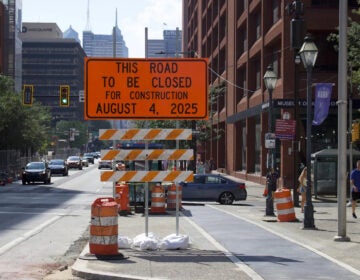PCPC hears about vision, overlay and CED

April 21, 2009
(Updated April 22, 2009)
By Thomas J. Walsh
For PlanPhilly
Two very broad issues concerning the Central Delaware Riverfront dominated the first half of the April meeting of the Philadelphia City Planning Commission Tuesday afternoon. One, the PennPraxis Civic Vision for the Central Delaware, was wide in scope, employing the imagination with serious, long-term dreams of a revitalized waterfront.
The other was legislative and bureaucratic, involving several city agencies, regulations and ordinances that form a sort of floating patch called a “zoning overlay district” to create interim development guidelines for the riverfront. That means the two issues are inextricably linked, with the overlay’s guidelines framing the course of development while the PennPraxis Civic Vision takes its final shape.
The Commission approved the vision, but for at least a month, it and the overlay guidelines will be out of sync with each other, as Councilman Frank DiCicco, on hand to testify, requested the delay to work out a few more of the kinks. Both pieces of legislation will go before City Council within the next six weeks.
The overlay actually consists of two bills, with one them serving as a remapping for the Old City, Northern Liberties, and Fishtown sections of the Central Delaware.
PennPraxis, the clinical arm of the Penn School of Design, had input from more than 4,000 Philadelphians over the course of a year as they stated their own visions of the Delaware, from Allegheny to Oregon Avenues.
Executive Director Harris Steinberg, in his presentation Tuesday, stressed “a long-term vision; this is not a plan, it’s a vision,” along with three factors to establish a framework for growth in a “dense, urban, walkable, multi-modal and sustainable” city: movement systems (streets, public transit, trails); parks and open space; and mixed-use development.
“The citizens who participated in the process called for a reconnection between the neighborhoods and the river, between the city and the river,” Steinberg said, a connection long severed by Interstate 95 and in areas by Columbus Boulevard and remnants of Philadelphia’s industrial past.
“Striking a balance is important – what are the uses and how do we measure and encourage a variety of different uses, everything from the working port to industrial to residential to commercial, all of which create the opportunity [with] our framework for an extension of Philadelphia to the river’s edge.
“It means taking the long view,” Steinberg repeated. “This is a long-term vision.”
He then dove into the topic of “public investment in infrastructure and private value,” a divisive one among riverfront stakeholders and developers. “Philadelphians told us they didn’t want this to be the Inner Harbor [in Baltimore] or another city’s waterfront. They wanted really an extension of Philadelphia, in a real and tangible way.”
Planning Commission Executive Director Alan Greenberger said he’ll use the principles of the Civic Vision as a guide to the development of a master plan for the area. The master plan is expected to be finished by the fall of 2010.
Most of those testifying about the waterfront plan were there in support, but several developers objected that the PennPraxis plan is unrealistic and does not take into account the actual riverfront property owners. In addition to the controversial inclusion of a 100-foot setback (“where feasible”) for the seven-mile stretch, the vision includes a provision for 300 acres of the 1,146-acre tract to be open space. There are currently only eight acres of open space, Steinberg said.
More open space not only serves the area’s 60,000 residents with parks and trails, but also helps manage storm water and filter pollutants, helping to create a green infrastructure – all of it contributing to more valuable real estate and better development opportunities.
“We are committed to seeing the process through to implementation,” said Steven Weixler, chairman of the Central Delaware Advocacy Group (CDAG), which has been working with PennPraxis on the Civic Vision. “We are representative of more than 20 civic and neighborhood associations along the river. Support and commitment of neighborhood Philadelphians to a world-class waterfront is unwavering.”
There was something of a sheepish undertone to many of the comments, pro or con, from those testifying to the vision. It’s because if all goes well, the vision, in whatever final form it takes, will not be realized for 30 to 50 years, well beyond the life-spans of nearly everyone in the room.
The opposition
Michael Sklaroff spoke on behalf of Development Workshop Inc., a nonprofit which he said is dedicated to development throughout the city, creating construction jobs and bringing new families to Philadelphia to strengthen its tax base. He was by far the vision’s most vocal critic at Tuesday’s meeting.
With former City Planning officers as members, along with designers, economic and redevelopment experts, union leaders, architects and engineers, Sklaroff said the group fully supports revitalizing the waterfront and “reasonable access to the river.”
“Many of our members not only support those values, but have invested in them,” Sklaroff said. “We commend PennPraxis for its urban design exercise. … We are here, however, to express our concern about the Civic Vision,” and to submit a position paper.
That paper, he said, includes the Planning Commission’s “Central Riverfront District Plan of 1982” and the Commission’s “Philadelphia Riverwalk Planning Design Standards” from 1983.
“This river has been planned,” explained Sklaroff, at times wagging his finger at the commissioners. “If you look at the Civic Vision you will see a 1681-to-the-present timetable, but you will not see one reference to this commission’s work product from 1982 or 1983, because there’s a fiction going on – and that is that ‘There’s been no planning of the river, that the developers planned the river,’ and the fact is that this commission planned the river. City Council zoned and re-mapped in accordance with that, and developers developed.”
Sklaroff was just getting warmed up when his three minutes ran out, a time limit he objected to, given who he was representing, he said. Commission Chairman and Deputy Mayor for Planning and Commerce Andrew Altman, looking at the list of those waiting to speak, agreed and granted him another two minutes.
“Our major concern is that Harris Steinberg … has said there’s a partnership between the public sector and the private sector,” Sklaroff continued. “You don’t have a partnership if you don’t invite the private sector to the table.
“What is missing here – it’s the sound of one hand clapping – are the people who are the actual landowners of the 1,146 acres, most of them in private ownership along the waterfront, who will be impacted not only by the new regulations, but by an overlay of 100 feet [the suggested setback], which has never been mapped, not one time yet. With incredible cost to the public which may not be supported, not only in the near future but in the distant future.”
A lack of cost estimates for implementing the Civic Vision was an overriding theme of concern for Sklaroff and his colleagues, he said. “It hasn’t been mapped, it hasn’t been priced, the people who are affected have not been identified. And I’m a little concerned because it was my understanding that the Commission would be accepting this as a guideline, but when you say you’re accepting it as the guideline, I think that’s a little ambiguous.”
Cross-examination?
The very next speaker was Matt Ruben, president of the Northern Liberties Neighborhood Association and a member of CDAG, testifying on behalf of the NLNA. Rubin said the Civic Vision was “definitive” and not at all ambiguous, and proceeded to argue Sklaroff’s points.
“I don’t think what PennPraxis did and what CDAG participated in for over a year was an ‘exercise,’ as Mr. Sklaroff characterized it,” Ruben said. “It was a very serious, unprecedented planning effort in the city’s history, and the issue is not whether or not the Commission or any other body have promulgated plans before, the question is have there been good plans, and workable plans and up-to-date plans been promulgated. And the answer is no, which is why we need this vision plan, and the Action Plan, and the eventual master plan.”
Ruben also countered Sklaroff’s assertion that there has been no partnership with private developers. Just prior to former Mayor John Street’s commissioning of PennPraxis for the Central Delaware plan, the NLNA took part in a similar study with other organizations, completed in early 2007. (The 97-page document can be downloaded here: http://www.nlna.org/downloads.html)
“It anticipates and supports almost exactly the basic principles of the Civic Vision,” Ruben said. More to the point, the published plan includes a thank you in its first pages to eight waterfront developers who not only participated in the plan but actually funded it.
“So there’s a fiction out there, indeed, that there’s not been a partnership. There’s a fiction out there that the development community, including those with a stake on the waterfront, have not participated in discussions like these.”
Two others voiced concerns or opposition to the Civic Vision, including Al Johnson, former vice president of AFSCME District Council 33 and a waterfront business owner. In addition to submitting his own plans, Johnson called the PennPraxis vision “myopic” and “brain-dead.”
“I live on the waterfront, and nobody – people who have boats there, people who have businesses there … they were never talked to,” claimed Johnson. “It’s charming, but it shouldn’t be public policy.” Combined with the overlay, he said, the Civic Vision is over-restrictive and will keep developers away. “Go sell the land” to developers. “I’ve watched 20 years, and nothing has happened.”
Others testifying in favor of the Civic Vision included Sarah Clark Stuart of the Schuylkill River Park Alliance and Patrick Starr, vice president of the Pennsylvania Environmental Council.
Full schedule
It was a busy day for the Commission, which also approved key zoning changes that will allow the Foxwoods Philadelphia casino partnership to move forward with a plan of development for its newly chosen site at the old Strawbridge’s department store, at 8th and Market streets.
Testimony was lengthy for both issues. The casino zoning drew another large anti-casino crowd. (See accompanying article.)
The Commission also approved extending the sunset clause for the Stamper Square project near South Street, which would allow the developer another year to keep the project’s approved plan of development. Poor economic conditions for developers everywhere necessitated the move, Greenberger said. (See accompanying article.)
Notes:
Greenberger confirmed that a project manager for the Central Delaware Riverfront Master Plan is now being sought. Details on the position can be seen via a request-for-proposal on the Web site of the Delaware River Waterfront Corp. (DRWC): http://www.delawareriverwaterfrontcorp.com/index.php?pageID=49ℑ=14a.
There is also an RFP for the “Design Development for Pier 11,” with a link just below on the same page.
The Executive Committee of the DRWC Board of Directors meets Friday morning (April 24), 8:30 a.m. to 10 a.m., at its 121 N. Columbus Blvd. office. It is open to the public, and PlanPhilly will provide coverage later that day.
***
The day’s first order of business had to do with further empowering Greenberger by amending commission regulations that would allow “discretionary authority” for him and succeeding directors to grant extensions on one-year sunset clauses.
The commissioners voted to approve the amendment, which gives Greenberger the freedom to extend sunset periods and other plans of development without requiring any further formal action.
The amendment was proposed after the Commission, in November, authorized the executive director of the Planning Commission to make recommendations on certain types of bills before City Council, to make recommendations on Zoning Board of Adjustment cases and to approve other minor changes to certain mapping decisions and to “IDDs” (Institutional Development Districts).
***
The Planning Commission will be honored next month by the Preservation Alliance of Greater Philadelphia for its “Philadelphia Rowhouse Manual,” a 48-page publication on how owners can adapt their rowhouse for modern living without compromising basic form and architecture. (Press release on all winners: http://www.preservationalliance.com/files/press-releases/_R_%20Awards.pdf). Greenberger singled out staffer Laura Spina for her work on the publication.
Related articles:
Stamper Square gets another lease on life
Foxwoods moving ahead at Strawbridge site
Contact the reporter at thomaswalsh1@gmail.com.
WHYY is your source for fact-based, in-depth journalism and information. As a nonprofit organization, we rely on financial support from readers like you. Please give today.





